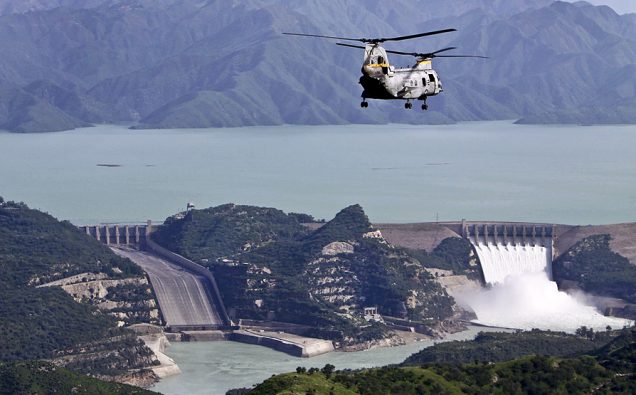
Tarbela Dam during 2010 floods Photo Credit: Paul Duncan, U.S. Marine Corps via Wikimedia Commons
This week Pakistan made its latest nuclear power project – a 340 MW Chashma-3 (C-3) plant – operational and connected it to the national grid.
The country has now four nuclear power generation facilities, promising some bailout to the South Asian country fromt he lingering energy crisis.
The construction of the Chinese-designed CNP-300 by China National Nuclear Corporation (CNNC) began in March 2011, and will help increase Pakistan’s total nuclear power generation to 1040 Megawatts.
The country has been producing energy for more than four decades with the first nuclear power plant KANUPP in Karachi established with the help of Canada in 1972. The other three nuclear power plants CHASNUPP I, CHASNUPP II and CHASNUPP III, are operating in Chashma town along River Indus in Central Pakistan province of Punjab.
Chashma-3 was one of two CNP – 300 units being built at the site. Unit 4, which saw construction begin nine months after unit 3, is currently going on with commissioning and is expected to enter commercial operations in 2017. Another two nuclear power plants K-2 and K-3 are going to be completed by the year 2021 to add another 2200 megawatt to the national grid.
But power generation in Pakistan has dwindled over the decades due to a variety of factors including corruption, governmental negligence, political opposition to various projects, line losses and fast-expanding requirements – creating a huge gap in demand and production.
The total generation capacity of IPPs (Independent Power Producers) is 7070 MW while total electricity generated from nuclear plants is over 1000 megawatts. The total power generation capacity of Pakistan is 21,143 MW and the electricity demand is 14,500 MW while power generation companies (GENCOs) are merely generating 10,000 MW.
Although, Pakistan inherited a very weak power generation system at the time of independence in 1947 – just 60MW of power generation capability for a population of 31.5 million, which yielded 4.5 units per capita consumption – it has also wasted many opportunities.
When Water and Power Development Authority was created in 1959, the country’s generation capacity had increased to 119 MW. The task of accelerating the pace of power development picked up speed and by 1970, in another five years the generating capability rose from 636 MW to 1331 MW with installation of a number of thermal and hydel power units. The construction of Mangla Dam and later Tarbela Dam helped Pakistanis have access to more cheap hydel power.
In the year 1980 the system capacity touched 3000 MW which rapidly rose to over 7000 MW in 1990-91.
During the 1990s, private sector was engaged in the power generation by allowing them set up Independent Power Plants (IPPs). Ghazi Barotha Hydropower Project with a generation capacity of 1480 megawatts.
As for expansion in hydel power generation, Pakistan’s domestic politics along provincial lines have for long blunted the possibility of materializing Kalabagh Dam, which neutral experts, say will benefit the entire country. A new large project on Diamer Bhasha Dam has also not seen much progress.
Meanwhile, the demand for electricity has been soaring at a rate of 10 percent per annum, frustrating any efforts to address the energy crisis. The power load management was introduced during military dictator General Pervez Musharraf’s regime but the power crisis got worst during the PPP government that succeeded Musharraf’s rule. Pakistan Muslim League of Prime Minister Nawaz Sharif won the 2013 elections with the promise to end power outages and blackouts. But it is still struggling to fulfill its promise.
According to energy experts, there is a need for quantum jump in power generation with the construction of hydel power projects – that will provide much cheaper electricity to run the industry and lit houses in a country of 190 million people, and growing.
Pakistan needs to have more and more electricity from low cost fossil fuels like natural gas and coal instead of relying on furnace oil and diesel that have been responsible for the soc-called circular debt in the power sector in the recent years and becomes a drain on national economy.
In recent years Pakistan has seen some new projects and is now building the lagest solar panel, and with Chinese help also pursuing a number of smaller energy generation projects under China Pakistan Economic Corridor.
Sharif must work against time to fulfill his political promise or else the rhetoric would cost him dearly, come 2018 election.
For Pakistan energy shortage is both a political and economic issue at the same time. The CPEC and alternate sources of energy combined could be the best answer to Pakistan’s energy problems in the absence of large hydel projects. Sharif’s troubles will multiply if he does not resolve the power crisis.


















